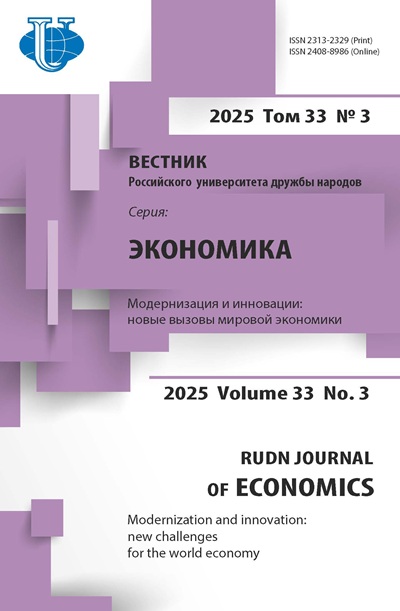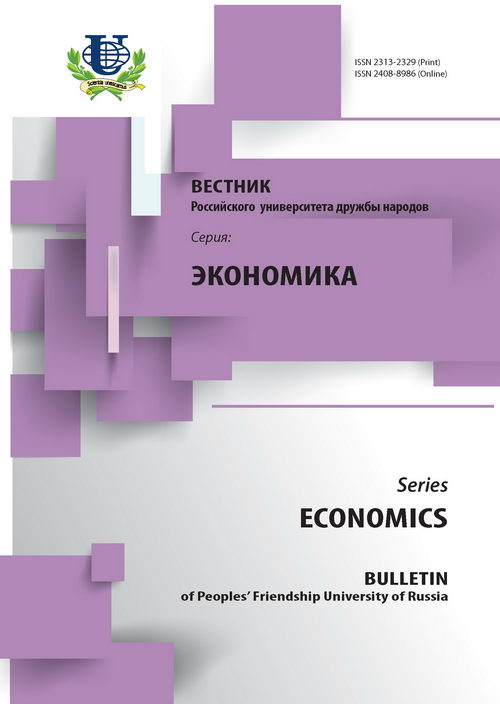Подходы к оценке теневой экономической деятельности
- Авторы: Коняева АА1
-
Учреждения:
- Российский университет дружбы народов
- Выпуск: № 1 (2008)
- Страницы: 92-100
- Раздел: Статьи
- URL: https://journals.rudn.ru/economics/article/view/11860
- ID: 11860
Цитировать
Полный текст
Аннотация
Статья посвящена анализу существующих в экономической теории методов определения масштабов развития теневой экономической деятельности. Значительный рост теневой экономики в последние время и изменение форм ее проявления обусловили необходимость анализа методов ее измерения. Целью данной статьи является рассмотрение используемых методов измерения теневой экономики, выявление их достоинств и недостатков в результате сопоставления, выработки критериев их классификации.
Список литературы
- Cagan Ph. The Demand for Currency Relative to the Total Money Supply // Journal of Political Economy. - 1958. - Vol. 66/3.
- Tanzi V. Uses and Abuses of Estimates of the Underground Economy // The Economic Journal. - 1999. - Vol. 109/456.
- Schneider F., Enste D. Shadow Economies: Size, Causes, and Consequences // The Journal of Economic Literature. - 2000. - Vol. 38/1.
- Contini B. Labor market segmentation and the development of the parallel economy - the Italian experience // Oxford Economic Papers. - 1981. - Vol. 33/4. - P. 401.; Del Boca D. Parallel economy and allocation of time, Micros // Quarterly Journal of Microeconomics. - 1981. - Vol. 4/2.
- Feige E. Overseas holdings of U.S. currency and the underground economy // Exploring the Underground Economy. Editor: Pozo S. - Kalamazoo, Michigan. - 1996.
- Cagan Ph. The Demand for Currency Relative to the Total Money Supply // Journal of Political Economy. - 1958. - Vol. 66/3.
- Schneider F. Further empirical results of the size of the shadow economy of 17 OECD-countries over time // Working paper. University of Linz. Linz, Austria. - 1998.; Williams C., Windebank J. Black market work in the European Community: Peripheral work for peripheral localities? // International Journal of Urban and Regional Research. - 1995. - Vol. 19/1. - P. 23; Johnson S., Kaufmann D., Zoido-Lobatón P. Regulatory discretion and the unofficial economy // The American Economic Review. - 1998. - Vol. 88/2. - P. 387.
- Schneider F., Enste D. Shadow Economies: Size, Causes and Consequences // The Journal of Economic Literature. - 2000. - Vol. 38/1.
- Isachsen A., Strom S. The Size and Growth of the Hidden Economy in Norway // Review of Income and Wealth. - 1985. - Vol. 31/1. - P.21; The Underground Economy in the United States and Abroad. Editor Tanzi V. Lexington, Mass.: Lexington Books. - 1982 -P. 209; Mogensen G., Kvist H., Kцrmendi E., Pedersen S. The Shadow Economy in Denmark 1994: Measurement and Results // Study No. 3, Copenhagen: The Rockwool Foundation Research Unit. - 1995.
- Schneider F., Enste D. Shadow Economies: Size, Causes and Consequences // The Journal of Economic Literature. - 2000. - Vol. 38/1.
- O'Higgins M. Assessing the underground economy in the United Kingdom // The underground economies: tax evasion and information distortion. Editor: Feige, E. Cambridge: Cambridge University Press. - 1989. - P. 175-195; Smith J. Market motives in the informal economy // The economics of the shadow economy. Editor: Gaertner W., Wenig A. Heidelberg: Springer Publishing Company. - 1985.
- The informal economy in the EU accession countries: Size, Scope, Trends and Challenges to the Process of EU Enlargement // Editor Belev B., Working paper, World Bank CSD. - 2003.
- Frey B., Weck H. Estimating the Shadow Economy: A 'Naive' Approach // Oxford Economic Papers. - 1983. - Vol. 35.
- Frey B., Weck-Hannemann H. The Hidden Economy as an «Unobserved» Variable // European Economic Review. - 1994. - Vol. 26/1. - P. 33; Giles D. Measuring the Hidden Economy: Implications for Econometric Modelling // The Economic Journal. - 1990. - Vol. 109/456.
- Schneider F. Shadow Economies of 145 Countries all over the World: Estimation Results over the Period 1999 to 2003 // Working Paper. Johannes Kepler University of Linz. Linz, Austria. - 2005.
Дополнительные файлы













